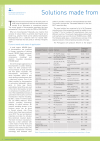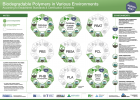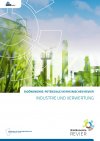Showing 61–80 of 133
-
291 Downloads
2022-08
FREE
Free Shipping291
DownloadsAvantium has developed a technology to convert plant-based sugars into FDCA (furandicarboxylic acid), the building block of PEF (polyethylene furanoate): a plant-based, fully recyclable polymer with superior performance. FDCA is polymerised with plant-based mono-ethylene glycol (MEG) to make a 100% plant-based PEF polymer. In December 2021, Avantium has taken a positive investment decision concerning the construction of the world’s first FDCA Flagship Plant in Delfzijl (The Netherlands), with construction planned to be completed by the end of 2023 and the aim to be operational in 2024. This will be the world’s first commercial FDCA facility and will have a targeted production capacity of 5,000 tonnes per annum. FDCA is the key building block for the 100% plant-based, recyclable polymer PEF.
-
153 Downloads
2022-08
FREE
Free Shipping153
DownloadsPEF has enhanced barrier, mechanical and thermal properties compared to today’s widely used
petroleum-based polymers. The barrier properties of PEF, which are ~10x better for O2, ~15x better
for CO2 and ~2.5x better for water than PET, represent a revolutionary opportunity compared with traditional packaging solutions regarding performance, price, and sustainability when produced at scale. The improved barrier properties lead to a longer shelf life of packaged products. PEF also offers higher mechanical strength, which means that thinner PEF packaging can be produced and fewer resources are required.
In terms of thermal properties, PEF has superior ability to withstand heat and can be processed at lower temperatures. PEF has enhanced mechanical stiffness and allows for increasing shaping possibilities. -
Life cycle stages of monolayer PEF bottles (PNG)
Sustainability & Health, Technology
1 Page
134 Downloads
134 Downloads
2022-08
FREE
Free Shipping134
DownloadsThis figure shows the relevant life cycle stages of monolayer PEF bottles from cradle-to-grave: from the biomass cultivation (wheat for fructose and sugarcane for bio-MEG feedstocks supply) to the production of PEF-based bottles including their end-of-life options (recycling and incineration).
It is foreseen that the commercialisation of PEF-based products will initially take place in the Netherlands, Belgium, and Germany. In these countries, the rates for average PET bottle waste collection and recycling are relatively high and landfilling is no longer practiced in these countries. -
Erneuerbarer Kohlenstoff – Schlüssel zur Zukunft (PDF)
Policy, Sustainability & Health, Technology
2 Pages
346 Downloads
346 Downloads
2022-07
FREE
Free Shipping346
DownloadsDie chemische Industrie steht aktuell vor einer Vielzahl an Herausforderungen, aus denen eine neue, nachhaltige Chemie erwachsen kann – wenn die große Transformation in den nächsten Jahrzehnten gelingt. Und das muss sie!
Quelle: „Erneuerbarer Kohlenstoff – Schlüssel zur Zukunft“ – aus CHEManager 7/2022
https://www.chemanager-online.com/news/erneuerbarer-kohlenstoff-schluessel-zur-zukunft -
Mapping of advanced recycling – Providers, technologies, and partnerships – Short Version (PDF)
Technology
8 Pages
1407 Downloads
1407 Downloads
2022-06
FREE
Free Shipping1407
DownloadsAdvanced recycling technologies are developing at a fast pace, with new players constantly appearing on the market, from start-ups to giants and everything in between – new plants are being built, new capacities are being achieved, and new partnerships are established. Due to these developments, it is difficult to keep track of everything. The report “Mapping of advanced recycling technologies for plastics waste” aims to clear up this jungle of information providing a structured, in-depth overview and insight. It has an exclusive focus on profiling available technologies and providers of advanced recycling including the addition of new technologies and updated/revised profiles.
P.S.: All you want to know about advanced recycling technologies and renewable chemicals, building-blocks, monomers, and polymers based on recycling: Hear about it at the Advanced Recycling Conference (ARC), 28-29 November 2023, Cologne, Germany (hybrid event).
-
2022-06
2,500 € – 10,000 €Price range: 2,500 € through 10,000 € ex. tax
Plus 19% MwSt.Press
release Select
licenceAdvanced recycling technologies are developing at a fast pace, with new players constantly appearing on the market, from start-ups to giants and everything in between – new plants are being built, new capacities are being achieved, and new partnerships are established. Due to these developments, it is difficult to keep track of everything. The report “Mapping of advanced recycling technologies for plastics waste” aims to clear up this jungle of information providing a structured, in-depth overview and insight. It has an exclusive focus on profiling available technologies and providers of advanced recycling including the addition of new technologies and updated/revised profiles.
Further information:
The new report “Mapping of advanced recycling – Providers, technologies, and partnerships” differs from the old report “Chemical Recycling – Status, Trends and Challenges” as follows:
- All technology provider profiles from the old report included + updated to 2022.
- Overall >100 technologies and providers (vs. >70 technologies and providers in the old report)
- Extensive introductory part on polymer types, demand of different polymer types, waste fractions, political framework, position papers, technologies, LCAs, associations and waste management companies are no longer included in this report
In summary, this report is suitable for interested readers who have already dealt with the advanced recycling topic and are looking for an up-to-date overview of all identified providers and a detailed description of the technologies.
DOI No.: https://doi.org/10.52548/ITZE5668
P.S.: All you want to know about advanced recycling technologies and renewable chemicals, building-blocks, monomers, and polymers based on recycling: Hear about it at the Advanced Recycling Conference (ARC), 28-29 November 2023, Cologne, Germany (hybrid event).
-
Identified Advanced Recycling technology providers worldwide and maximum capacity (PNG)
Technology
1 Page
340 Downloads
340 Downloads
2022-06
FREE
Free Shipping340
DownloadsOverview about identified advanced recycling technology providers (blue bars) and maximum capacity (orange lines) depending on the technology.
-
887 Downloads
2022-06
FREE
Free Shipping887
DownloadsLife of a polymer from the production to its disposal (e.g. landfill) indicated with black arrows including various recycling and recovery routes indicated in different coloured arrows.
-
558 Downloads
2022-06
FREE
558
DownloadsAdvanced recycling technologies are developing at a fast pace, with new players constantly appearing on the market, from start-ups to giants and everything in between – new plants are being built, new capacities are being achieved, and new partnerships are established. Due to these developments, it is difficult to keep track of everything. The report “Mapping of advanced recycling technologies for plastics waste” aims to clear up this jungle of information providing a structured, in-depth overview and insight. It has an exclusive focus on profiling available technologies and providers of advanced recycling including the addition of new technologies and updated/revised profiles.
-
Renewable Materials Conference, 10-12 May 2022 (Proceedings)
Markets & Economy, Policy, Sustainability & Health, Technology
252 Downloads
252 Downloads
2022-05
FREE
Plus 19% MwSt.252
DownloadsThe proceedings of the Renewable Materials Conference (10-12 May 2022, https://renewable-materials.eu) contain conference presentations, the conference journal, and the press release of the three winners of the innovation award “Renewable Material of the Year”!
-
RCI’s scientific background report: “CO2 reduction potential of the chemical industry through CCU” (May 2022)
Sustainability & Health, Technology
28 Pages
1943 Downloads
1943 Downloads
2022-05
FREE
1943
DownloadsIn an exploratory scenario, this study investigates the CO₂ emission reductions that can be achieved in the global chemical and derived material industries if the entire demand for embedded carbon is met solely and exclusively via CO₂ instead of from fossil sources. Major simplifications are used to achieve transparency and comprehensibility of the issue. Methanol (CH3OH) is considered to cover the needs for hydrocarbons for chemicals and derived materials among the various chemical intermediates as a representative pathway for renewable carbon. It is a plausible scenario to assign methanol a central role in supplying the chemical industry of the future.
The GHG emissions of CCU-based methanol could be 67 to 77 % lower compared to emissions from releasing embedded carbon of fossil fuels, when using current energy supply based on photovoltaics. With improvements in renewable energy production, the reduction could increase to levels between 96 and 100 %.
DOI No.: https://doi.org/10.52548/UTRL5869
-
CCU-based Resource Supply for the Chemical Industry (PNG)
Sustainability & Health, Technology
1 Page
251 Downloads
251 Downloads
2022-05
FREE
251
DownloadsIt is a plausible scenario to assign methanol (CH₃OH) a central role in supplying the chemical industry of the future. Already today, methanol plays an important role in the chemical industry, being one of the most established commodities.
CCU-based process route for production of methanol includes production of hydrogen via electrolysis, CO₂ capture from the atmosphere or from industrial point sources, and the hydrogenation reaction. Electricity demand for these processes is represented by red arrows. Above the arrow, the specific energy demand is stated, below, the contribution of the process to the total electricity demand of 1 t of methanol is stated. Purification and compression of hydrogen are neglected. For CO₂ hydrogenation, a complete reaction is assumed.
-
CO₂ Emissions From Embedded Carbon in Chemicals (PNG)
Sustainability & Health, Technology
1 Page
299 Downloads
299 Downloads
2022-05
FREE
299
DownloadsWhen fossil feedstock is used, the fossil-based embedded carbon contained in chemicals and materials is emitted to the atmosphere at their end of life, assuming complete oxidation (e.g. through combustion or (bio)degradation).
When using CCU-based feedstock to replace the fossil feedstock, at the end of life, no additional carbon (or CO2, respectively) is emitted to the air because it was captured from the air (or from point sources) before through carbon capture. Only the electricity demand for CCU-based feedstock production causes CO2 emissions.
-
Emission Reduction Potential for Replacing Fossil Feedstock with CCU-based Methanol (PNG)
Sustainability & Health, Technology
1 Page
194 Downloads
194 Downloads
2022-05
FREE
194
DownloadsAt end of life, carbon embedded in chemicals and derived materials is released to the atmosphere as CO₂. In the case of fossil-based feedstock, this contributes to global warming. For CCU-based feedstock this is not the case, since all carbon embedded in these products was captured from the air (or from point sources) before through carbon capture. In a simplified model, additional emissions only electricity production for causes emissions for CCU-based feedstock production. Only the use of renewable energy can save emissions.
The GHG emissions of CCU-based methanol could be 67 to 77 % lower compared to emissions from releasing embedded carbon of fossil fuels, when using current energy supply based on photovoltaics. With improvements in renewable energy production, the reduction could increase to levels between 96 and 100 %. -
Conference on CO2-based Fuels and Chemicals 2022 Proceedings
Markets & Economy, Policy, Sustainability & Health, Technology
106 Downloads
106 Downloads
2022-04
FREE
Plus 19% MwSt.106
DownloadsThe proceedings of the Conference on CO2-based Fuels and Chemicals 2022 (23-24 March 2022, https://co2-chemistry.eu) contain 26 presentations, the conference journal, and the press release of the three winners of the Innovation Award “Best CO2 Utilisation 2022“.
-
International Conference on Cellulose Fibres 2022 Proceedings
Markets & Economy, Policy, Sustainability & Health, Technology
170 Downloads
170 Downloads
2022-02
FREE
Plus 19% MwSt.170
DownloadsThe proceedings of the International Conference on Cellulose Fibres 2022 (2-3 February 2022, https://cellulose-fibres.eu) contain 26 presentations, the conference journal, and the press release of the three winners of the Cellulose Fibre Innovation of the Year 2021 Award!
-
830 Downloads
2021-11
FREE
830
DownloadsToday, the various biocomposites can be easily used in a wide range of applications and have reached the mass market as an alternative to conventional plastics. The annual growth of biocomposite granulates has been estimated be 5 % by nova-Institut for 2020 to 2028 (CAGR). What are biocomposites? Basically, any material that consists of natural fibres or particles and a binder (e.g., polymer, resin) can be called a biocomposite. Biocomposites are a collective term for natural fibre-reinforced materials that are partly or entirely of biogenic origin. The report shows a full list of all biocomposite granulate producers in Europe.
-
Biodegradable Polymers in Various Environments According to Established Standards and Certification Schemes – Graphic (PNG, Version 2021)
Sustainability & Health, Technology
1 Page
1927 Downloads
1927 Downloads
2021-11
FREE
Free Shipping1927
DownloadsNew updated version of the poster on Biodegradable Polymers in Various Environments According to Established Standards and Certification Schemes
The popular poster has been once again updated this autumn to depict to most up-to-date status of commercially available polymers which actually biodegrade in accordance with established standards and certification schemes. An additional partner rounds up this team of leading experts in the area of biodegradable polymers.
-
Biodegradable Polymers in Various Environments According to Established Standards and Certification Schemes – Graphic (PDF, Version 2021)
Sustainability & Health, Technology
1 Page
3323 Downloads
3323 Downloads
2021-11
FREE
3323
DownloadsNew updated version of the poster on Biodegradable Polymers in Various Environments According to Established Standards and Certification Schemes
The popular poster has been once again updated this autumn to depict to most up-to-date status of commercially available polymers which actually biodegrade in accordance with established standards and certification schemes. An additional partner rounds up this team of leading experts in the area of biodegradable polymers.
-
Studie Bioökonomie: Potenziale im Rheinischen Revier – Industrie und Verwertung (PDF)
Markets & Economy, Technology
76 Pages
115 Downloads
115 Downloads
2021-11
FREE
115
DownloadsEine Transformation der Wirtschaftsweise mit nachhaltigen, biobasierten Methoden eröffnet der Industrie einmalige Chancen für den Strukturwandel im Rheinischen Revier. Doch wie genau sehen die Beschäftigungseffekte, Umsätze sowie die Relevanz regionaler Industrie-Sektoren für eine biobasierte Wertschöpfung im Einzelnen aus?
Das nova-Institut hat im Auftrag der Strukturwandelinitiative BioökonomieREVIER hierzu eine Studie vorgelegt. Sie beleuchtet qualitative und quantitative Potenziale der Industrien in der Region. Diese erste Bestandsaufnahme zeigt, dass die regionale Sektorenvielfalt förderlich sein wird für die Etablierung neuer, branchenübergreifender Wertschöpfungsketten.




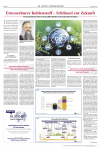
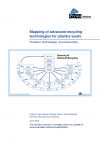


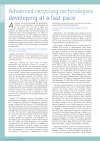
![Renewable Materials Conference, 10-12 May 2022 (Proceedings) [Digital]](https://renewable-carbon.eu/publications/wp-content/uploads/2020/05/21-01-07_RC-Publications-Cover-Proceedings_RMC-100x141.png)
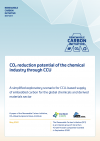



![Conference on CO2-based Fuels and Chemicals 2022 Proceedings [Digital]](https://renewable-carbon.eu/publications/wp-content/uploads/2020/05/21-01-07_RC-Publications-Cover-Proceedings_CO2-based-100x141.png)
![International Conference on Cellulose Fibres 2022 Proceedings [Digital]](https://renewable-carbon.eu/publications/wp-content/uploads/2020/05/21-01-07_RC-Publications-Cover-Proceedings_Cellulose-Fibres-100x141.png)
